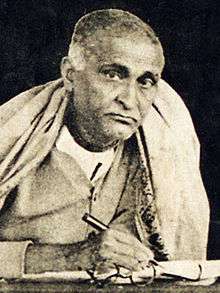A. C. Bhaktivedanta Swami Prabhupada
Abhay Charanaravinda Bhaktivedanta Swami (Abhaya Caraṇāravinda Bhaktivedānta Svāmī; 1 September 1896 – 14 November 1977), born Abhay Charan De, was an Indian spiritual teacher and the founder-preceptor of the International Society for Krishna Consciousness[2] (ISKCON), commonly known as the "Hare Krishna Movement". Members of the ISKCON movement view Bhaktivedānta Swāmi as a representative and messenger of Krishna Chaitanya.[3][4][5][6] Within the society he is commonly referred to as Shrila Prabhupāda or Prabhupāda.
His Divine Grace Abhay Charanaravinda Bhaktivedanta Swami Prabhupāda | |
|---|---|
.jpg) Bhaktivedānta Swami, 1974 in Germany | |
| Personal | |
| Born | Abhay Charan De 1 September 1896 Calcutta, Bengal Presidency, British India |
| Died | 14 November 1977 (aged 81) Vrindavan, Uttar Pradesh, India |
| Resting place | Bhaktivedānta Swami's Samadhi, Vrindavan |
| Religion | Hinduism |
| Nationality | Indian |
| Denomination | Vaishnavism |
| Lineage | Brahma-Madhva-Gaudiya Sampradaya |
| Sect | Gaudiya Vaishnavism |
| Notable work(s) | Bhagavad-gītā As It Is, Śrīmad Bhāgavatam, Caitanya Caritāmṛta |
| Alma mater | Scottish Church College of the University of Calcutta (B.A.)[1] |
| Monastic name | Abhaya Charanaravinda Bhaktivedanta Swami |
| Temple | Gaudiya Math, ISKCON |
| Philosophy | Achintya Bheda Abheda |
| Religious career | |
| Teacher | Bhaktisiddhānta Sarasvatī |
| Based in | Vrindavan, India |
| Period in office | 1966–1977 |
| Predecessor | Bhaktisiddhānta Sarasvatī |
| Initiation | Gauḍīya Vaiṣṇava Diksa 1933 by Bhaktisiddhānta Sarasvatī |
| Ordination | Gaudiya Sannyasa, 1959, by Bhaktiprajnāna Keśava Gosvāmī |
| Post | Guru, Acārya |
| Website | Official Website of ISKCON Official Website of Prabhupada |
Born in Kolkata (then called Calcutta), he was educated at the Scottish Church College there.[1] Before adopting the life of a novice renunciate (vanaprastha) in 1950,[7] he was married with children and owned a small pharmaceutical business.[8][9] In 1959 he took a vow of renunciation (sannyasa) and started writing commentaries on Vaishnava scriptures.[10] In his later years, as a travelling Vaishnava monk, he became an influential communicator of Gaudiya Vaishnava theology to India and specifically to the West through his leadership of ISKCON, founded in 1966.[11][12] As the founder of ISKCON, he "emerged as a major figure of the Western counterculture, initiating thousands of young Americans."[13] He received criticism from anti-cult groups, as well as a favourable welcome from religious scholars such as J. Stillson Judah, Harvey Cox, Larry Shinn and Thomas Hopkins, who praised Bhaktivedānta Swāmi's translations and defended the group against distorted media images and misinterpretations.[14] In respect to his achievements, religious leaders from other Gaudiya Vaishnava movements have also given him credit.[15]
He has been described as a charismatic leader, in the sense used by sociologist Max Weber, as he was successful in acquiring followers in many countries including the United States, Europe and India.[16][17][18] His mission was to propagate throughout the world Gaudiya Vaishnavism, a school of Vaishnavite Hinduism that had been taught to him by his guru, Bhaktisiddhanta Sarasvati.[11] After his death in 1977, ISKCON, the society he founded based on a form of Hindu Krishnaism using the Bhagavata Purana as a central scripture, continued to grow. In February 2014, ISKCON's news agency reported reaching a milestone of distributing over half a billion of his books since 1965. His translation of and commentary on the Bhagavad Gītā, titled Bhagavad-gītā As It Is, is considered by ISKCON adherents and many Vedic scholars as one of the finest translations into the English Language of Vaishnavism literary works.[3][4][5][6][19]
Honorifics
- Swāmījī – original honorific used by American disciples
- Prabhupāda – bestowed by American disciples, 1968, popularised by ISKCON
- Śrīla Prabhupāda – bestowed by American disciples, 1968, popularised by ISKCON
- His Divine Grace – title of address bestowed by American disciples, popularised by ISKCON
- Svāmī Mahārāj – used in his home denomination Gauḍīya Maṭha (where "Prabhupāda" is confined to Bhaktisiddhānta Gosvāmī)
- Śrīla Bhaktivedānta – used in Chaitanya Mission / Science of Identity (where "Prabhupad" is confined to Chris Butler)
Life
Early life
Born on 1 September 1896, the day after Janmastami, one of the most important Hindu festivals, in a humble house in Calcutta to a Bengali kayastha family,[20] he was named Abhay Charan, "one who is fearless, having taken shelter at Lord Krishna's feet." Since he was born on the day of Nandotsava ("the celebration of Nanda," Krishna's father, a traditional festival in honour of Krishna's birth) he was also called Nandulāl. His parents, "Sriman" Gour Mohan De and "Srimati" Rajani De, were devout Vaishnavas (devotees of Vishnu). In accordance with Bengali tradition, his mother had gone to the home of her parents for the birth, and only a few days later Abhay returned with parents to his home at 6 Sitakanta Banerjee Lane, Kolkata.[21]
He received a European-style education at the Scottish Church College, which was well regarded among Bengalis; many Vaishnava families sent their sons there. The professors, most of whom were Europeans, were known as sober, moral men. The college was located in north Calcutta, near the De's family home on Harrison Road. In the college, Abhay Charan De (অভয়চরণ দে) was a member of the English Society as well as that of the Sanskrit Society, and it has been suggested that his education provided him with a foundation for his future leadership.[8][21] He graduated in 1920 with majors in English, philosophy and economics.[22] He rejected his diploma in response to Gandhi's independence movement.[23]
At 22 years of age he married Radharani Devi, who was then 11 years old, in a marriage arranged by their parents. At 14, she gave birth to their first son.[24]
Religious journey
| Part of a series on |
| Vaishnavism |
|---|
 |
|
Holy scriptures
|
|
Sampradayas
|
|
Teachers–acharyas
|
|
Related traditions
|
|
|
In 1922, when he first met his spiritual master, Bhaktisiddhanta Sarasvati Thakura, he was requested to spread the message of Chaitanya Mahaprabhu in the English language.[25] In 1933 he became a formally initiated disciple of Bhaktisiddhānta. In 1944, (from his front room at Sita Kanta Banerjee, Calcutta), he started the publication called Back to Godhead,[26][27] for which he was writer, designer, publisher, editor, copy editor and distributor. He personally designed the logo, an effulgent figure of Chaitanya Mahaprabhu in the upper left corner, with the motto: "Godhead is Light, Nescience is darkness" greeting the readers.[28] In his first magazine he wrote:
Under the circumstances since 1936 up to now, I was simply speculating whether I shall venture this difficult task and that without any means and capacity; but as none have discouraged me, I have now taken courage to take up the work.
— A. C. Bhaktivedanta Swami, Back to Godhead magazine (Vol. 1, 1–4, 1944)[28]
In 1947, the Gaudiya Vaishnava Society recognised his scholarship with the title Bhaktivedanta, (bhakti-vedānta) meaning "one who has realised that devotional service to the Supreme Lord is the end of all knowledge"[29] (with the words Bhakti, indicating devotion and Vedanta indicating conclusive knowledge).[30]
His later well known name, Prabhupāda, is a Sanskrit title, literally meaning "he who has taken the shelter of the lotus feet of the Lord" where prabhu denotes "Lord", and pāda means "taking shelter."[31] Also, "at whose feet masters sit".[8] This name was used as a respectful form of address by his disciples from late 1967/early 1968 onwards. Previous to this, as with his early disciples, followers had called him "Swamiji".[32]
From 1950 onwards, he lived at the medieval Radha-Damodar mandir in the holy town of Vrindavan, where he began his commentary and translation work of the Sanskrit work Bhagavata Purana.[33] Of all notable Vrindavana's temples, the Radha-Damodar mandir had at the time the largest collection of copies of the original writings of the Six Gosvamis and their followers – more than two thousand separate manuscripts, many of them 300 to 400 years old.[34][35] His guru, Bhaktisiddhanta Sarasvati Thakura, had always encouraged him to print books, and beholding his spiritual master, Abhay felt the words deeply enter his own life – "If you ever get money, print books." [36] referring to the need for the literary presentation of the Vaishnava culture.[9]
Renunciation
The Gaudiya Matha at Prayagraj, Uttar Pradesh was where he lived, wrote and studied, edited the Gauḍīya Patrikā magazine and where he donated the deity of Chaitanya Mahaprabhu which stands on the altar beside those of Radha Krishna (named Śrī Śrī Rādhā Vinodavihārījī). During his visit in September 1959 he entered the doors of this matha dressed in white, as Abhoy Babu, but he left dressed in saffron, as a Vaishnava renunciate (sannyasi).[10] He took his renunciate vows from his friend and godbrother Bhakti Prajnana Keshava. On becoming a sannyasa he also took the prenominal Swami (स्वामी Svāmī). He single-handedly published the first three volumes covering seventeen chapters of the first book of Bhagavata Purana, filling three volumes of four hundred pages, each with a detailed commentary. The introduction to the first volume was a biographical sketch of Caitanya Mahāprabhu.[35] He then left India, obtaining free passage on a freighter called the Jaladuta, with the aim and hope of fulfilling his spiritual master's instruction to spread the message of Chaitanya Mahaprabhu around the world. In his possession were a suitcase, an umbrella, a supply of dry cereal, about eight dollars worth of Indian currency, and several boxes of books.[37]
Mission to the West
In 1936, just days before Bhaktisiddhanta Sarasvati's death, Srila Prabhupada[38] was specifically ordered to spread Krishna consciousness in the English language to the West. He did not take the mission given to him by his spiritual master with the utmost seriousness until he was reading a Bhagavadgita commentary written by Srila BhaktivinodeThakur, who was the father of Srila Bhaktisiddhanta Sarasvati.

When he sailed to the United States in 1965, his trip was not sponsored by any religious organization, nor was he met upon arrival by a group of loyal followers.[39] As the Indian freighter Jaladuta neared his destination, the magnitude of his intended task weighed on him. On 13 September he wrote in his diary, "Today I have disclosed my mind to my companion, Lord Sri Krishna."[40] On this occasion and on a number of others, he called on Krishna for help in his native Bengali. Examining these compositions, academics regard them as "intimate records of his prayerful preparation for what lay ahead" and a view on "how Bhaktivedanta Swami understood his own identity and mission."[41]
I do not know why You have brought me here. Now You can do whatever You like with me. But I guess You have some business here, otherwise why would You bring me to this terrible place? How will I make them understand this message of Krishna consciousness? I am very unfortunate, unqualified and most fallen. Therefore I am seeking Your benediction so that I can convince them, for I am powerless to do so on my own.[40][41]
By journeying to the United States, he was attempting to fulfil the wish of his guru, possible only by the grace of "his dear Lord Krishna".[41] It was in July 1966 that he brought "global missionary Vaishnavism" to the Western world,[2] founding the International Society for Krishna Consciousness (ISKCON) in New York City. He spent much of the last decade of his life setting up the institution. Since he was the Society's leader, his personality and his management capabilities were responsible for much of ISKCON's growth and the reach of his mission.
When it was suggested to him at the time of founding the ISKCON in 1966 that a broader term "God Consciousness" would be preferable to "Krishna Consciousness" in the title, he rejected this recommendation, suggesting that the name Krishna includes all other forms and concepts of God.[42]
After a group of devotees and a temple had been established in New York, another centre was started in San Francisco in 1967.[22][43] From there he travelled throughout America with his disciples, popularizing the movement through street chanting (sankirtana), book distribution and public speeches.
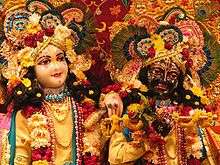
Once ISKCON was more established in San Francisco, a small number of devotees from the San Francisco temple were sent to London, England where they came into contact with The Beatles. George Harrison took the greatest interest, spending a significant amount of time speaking with him and producing a record with members of what became the London Radha Krsna Temple.[44]
Over the following years his continuing leadership role took him around the world several times setting up temples and communities on other continents.[45] By the time of his death in Vrindavan in 1977, ISKCON had become an internationally known expression of Vaishnavism.[22]
In the twelve years from his arrival in New York until his final days, he:
- circled the globe fourteen times on lecture tours that took him to six continents[45]
- initiated many disciples, awarding sannyasa initiations[46]
- introduced Vedic gurukul education to a Western audience[47]
- directed the founding of the Bhaktivedanta Book Trust,[48] which claims[49][50] to be the world's largest publisher of ancient and classical Vaishnava religious texts
- founded the religious colony New Vrindavan in West Virginia,[51]
- authored more than eighty books (with many available online[52]) on Vedantic philosophy, religion, literature and culture (including four published originally in Bengali)[45][50]
- introduced international celebrations such as Jagannatha processions[45]
- watched ISKCON grow to more than 108 temples, various institutes, and farm communities.[48]
Through his mission, he followed and communicated the teachings of Chaitanya Mahaprabhu and introduced bhakti yoga to an international audience.[45][50] Within Gaudiya Vaishnavism this was viewed as the fulfilment of a long time mission to introduce Caitanya Mahaprabhu's teachings to the world.[53][54]
In his discussion with historian Arnold J. Toynbee in London, he is quoted as saying: "I have started this Krishna Conscious Movement among the Indians and Americans and for the next ten thousand years it will increase."[55]
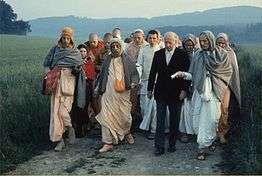
Bhaktivedanta Swami died on 14 November 1977 in Vrindavan, India, and his body was buried in Krishna Balaram Mandir in Vrindavan.
Books and publishing
Bhaktivedanta Swami's most significant contribution is considered to be his books.[56][57] During the final twelve years of his life, Bhaktivedanta Swami translated over sixty volumes of classic Vedic scriptures (such as the Bhagavad Gita, Chaitanya Charitamritaand the Srimad Bhagavatam) into the English language.[48] For their authority, depth and clarity, his books have won praise from professors at colleges and universities like Harvard, Oxford, Cornell, Columbia, Syracuse, Oberlin, and Edinburgh,[58] and his Bhagavad-gītā As It Is was published by Macmillan Publishers in 1968 with an unabridged edition in 1972.[59][60][61] It is now available in over sixty languages around the world and some other books by Bhaktivedanta Swami are available in over eighty different languages.[26][50] In February 2014, ISKCON's news agency reported to have reached a milestone of distributing over half a billion books authored by Bhaktivedanta Swami Prabhupada, since 1965.[19]
The Bhaktivedanta Book Trust was established in 1972 to publish his works, and it has also published his multi-volume biography, Srila Prabhupada-lilamrta, that according to Larry Shinn, will "certainly be one of the most complete records of the life and work of any modern religious figure".[2][62] Prabhupada reminded his devotees before his death that he would live forever in his books, and through them would remain present as a spiritual master or guru.[63] Bhaktivedanta Swami had instilled in his followers an understanding of the importance of writing and publishing not only with regard to his works, but also their own initiatives. His early disciples felt Prabhupada had given them Back To Godhead for their own writings from the very start.[63]
A prominent Gaudiya Vaishnava figure, Shrivatsa Goswami, who as a young man had met Bhaktivedanta Swami in 1972, affirmed the significance of book publishing and distribution in spreading the message of Caitanya in an interview with Steven Gelberg:[63]
Making these Vaisnava texts available is one of Srila Prabhupada's greatest contributions. Apart from the masses, his books have also reached well into academic circles and have spurred academic interest in the Chaitanya tradition ... The significance of making these texts available is not merely academic or cultural; it is spiritual.[64]
| Part of a series on |
| Hinduism |
|---|
 |
|
|
Main traditions
|
|
Concepts
|
|
Practices Worship
Arts
Festivals
|
|
Philosophical schools
|
|
Gurus, saints, philosophers
|
|
Texts Scriptures
Other texts
Text classification
|
|
Other topics
|
|
Bhaktivedanta Swami said:
Actually, it doesn't matter – Krishna or Christ – the name is the same. The main point is to follow the injunctions of the Vedic scriptures that recommend chanting the name of God in this age.[65]
Other typical expressions present a different perspective, where he would point out that "today I may be a Hindu, but tomorrow I may become a Christian or Muslim. In this way faiths can be changed, but dharma is a natural sequence, a natural occupation or a connection and it can not be changed, because it is permanent, according to him."[48] While the ISKCON theology of personal god is close to Christian theology, both personal and monotheistic, being a preacher of bhakti and a missionary he sometimes would add that "already many Christians have tasted the nectar of divine love of the holy name and are dancing with karatalas (hand-cymbals) and mridangas (drums)."[66]
His approach to modern knowledge is also seen in sectarian Orthodox Judaism, where the skills and technical knowledge of modernity are encouraged, but the values rejected. "Whatever our engagement is, by offering the result to Krishna we become Krishna conscious".[39] Some of his representations are believed to affect women adversely and are male-centred, others are tender and celebratory. Bhaktivedanta Swami himself taught a dualism of body and soul and that of the genders. Similar to many traditional religions he considered sexuality and spirituality as conflicting opposites.[67] Among some liberal male followers there is a positive recognition of his example in applying the spirit of the law according to time, place, person and circumstance, rather than literal tracing of the tradition.[68]
Within India
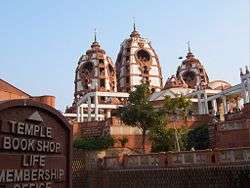

Beginning his public preaching mission in India, he founded the League of Devotees in Jhansi in 1953.[69]
Following the establishment of temples and centres in the United States and Europe, he returned to India in 1971, holding many public programs which were well attended. From 1971 onwards, the movement became increasingly popular and spread throughout India. He was particularly eager to see the progress on "the impressive temple project in" Mumbai which he and his disciples had fought with determination to establish,[70] with large temples in Mayapur and Vrindavan to follow in the mid-1970s. To promote the vedic education system within the modern Indian education structure, he introduced a chain of Gurukul in various part of India. The Bhaktivedanta Gurukula and International School is one of the most successful schools in the list.
In 1996, the Government of India recognized his accomplishments by issuing a commemorative stamp in his honour as a part of Prabhupada Centennial celebrations.[71][72]
Speaking at the inauguration of ISKCON's cultural centre in New Delhi on the occasion of Ramnavmi in 1998, Atal Bihari Vajpayee, then newly elected as India's prime minister, said:
If today the Bhagavad Gita is printed in millions of copies in scores of Indian languages and distributed in all nooks and corners of the world, the credit for this great sacred service goes chiefly to ISKCON. ... For this one accomplishment alone, Indians should be eternally grateful to the devoted spiritual army of Swami Prabhupada's followers. The voyage of Bhaktivedanta Swami Prabhupada to the United States in 1965 and the spectacular popularity his movement gained in a very short spell of twelve years must be regarded as one of the greatest spiritual events of the century.
— Atal Bihari Vajpayee – 5 April 1998 [73]
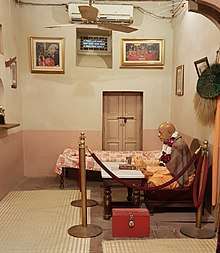
Monuments

A number of memorial samadhis or shrines to Bhaktivedanta Swami were constructed by the members of ISKCON in his remembrance, the largest of which are in Mayapur, Vrindavan and at the larger sized temples in the United States. Prabhupada's Palace of Gold was designed and constructed by devotees of the New Vrindavan community and dedicated on 2 September 1979. Back in 1972 it was intended to be simply a residence for Bhaktivedanta Swami, but over time the plans evolved into an ornate marble and gold palace which is now visited by thousands of Hindu pilgrims each year, visiting this centrepiece of the community strongly relying upon tourist trade.[51][74]
Bibliography
Translations with commentary

Summary studies
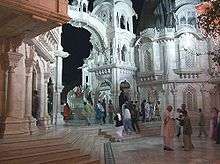
Other works published within Prabhupada's lifetime

- Easy Journey to Other Planets (1970)
- Kṛṣṇa Consciousness: The Topmost Yoga System (1970)
- Beyond Birth and Death (1972)
- The Perfection of Yoga (1972)
- Kṛṣṇa, the Reservoir of Pleasure (1972)
- On the Way to Kṛṣṇa (1973)
- Rāja-vidyā: The King of Knowledge (1973)
- Elevation to Kṛṣṇa Consciousness (1973)
- Kṛṣṇa Consciousness: The Matchless Gift (1974)
- Perfect Questions, Perfect Answers (1977)
- Teachings of Lord Kapila, the Son of Devahūtī
Bengali writings
- Geetār-gan
- Vairāgya-vidyā
- Buddhi-yoga
- Bhakti-ratna-boli[26]
See also
- List of International Society for Krishna Consciousness members and patrons
References
- Jones, Constance (2007). Encyclopedia of Hinduism. New York: Infobase Publishing. pp. 77–78. ISBN 978-0-8160-5458-9.
- Goswami et al. 1983, p. 986
- Melton, John Gordon. "Hare Krishna". Encyclopædia Britannica. www.britannica.com. Archived from the original on 11 April 2008. Retrieved 9 April 2015.
- "His Divine Grace A.C. Bhaktivedanta Swami Prabhupada". prabhupada.krishna.com.
- "Who is Srila Prabhupada?".
- "Avatar Credentials by his Divine Grace A.C. Prabhupada".
- Goswami 2002, Vol.1 Chapter 6
- Rhodes 2001, p. 178
- Goswami 2002, Vol.1 Chapter 4
- Goswami 2002, Vol.1 Chapter 9
- Klostermaier 2007, p. 217
- Ekstrand & Bryant 2004, p. 23
- Klostermaier 2007, p. 309
- Vasan & Lewis 2005, p. 129
- Paramadvaiti, Swami B. A. "Branches of the Gaudiya Math". www.vrindavan.org. Archived from the original on 4 July 2008. Retrieved 30 May 2008.
- Chryssides, George D. (2012). "Unrecognized charisma? A study and comparison of five charismatic leaders: Charles Taze Russell, Joseph Smith, L Ron Hubbard, Swami Prabhupada and Sun Myung Moon". Max Weber Studies. 12 (2): 185–204. doi:10.15543/MWS/2012/2/4. JSTOR 24579924.
- "in an evaluation of the nature of the guru, Larry Shinn, a scholar of religions, utilised Max Weber's analysis of charisma in order to understand Prabhupada and the issue of leadership in ISKCON..."status as charismatic leader" Knott 1997, Chapter: Prabhupada and role of guru
- Shinn 1987, p. 49
- Smullen, Madhava (12 February 2014). "BBT reaches half a billion books distributed since 1965". ISKCON News. Retrieved 27 February 2014.
- "Interview with Srila Prabhupada's Grand-Nephew - Sankarsan Prabhu". bvml.org. Retrieved 11 August 2017.
- Goswami 2002, Vol.1 Chapter 2
- Vasan & Lewis 2005, p. 128
- Eggenberger, D. 1989. Encyclopedia of World Biography: A to F.
- "Srila Prabjupada's marriage". Retrieved 7 May 2018.
- Goswami 1984, page xv
- Cole & Dwayer 2007, p. 34
- Goswami 1984, page xviii
- Goswami 2002, Vol. 1 Chapter 5
- Bhaktivedanta 2003, Ending Glossary
- A. C. Bhaktivedanta Swami, Satsvarupa dasa Goswami (1998) The secrets of transcendental love, ISBN 0-89213-273-6, p. 73: "The spiritual harmony of knowledge and devotion is well expressed in the phrase bhakti-vedānta"
- Aparna Chattopadhyay (2004). Pearls of Spiritual Wisdom. Pustak Mahal, India. p. 37. ISBN 81-223-0858-9.
- Goswami 2002, Vol.1 Chapter Planting the seed
- Charles S. J. White (2004). A Catalogue of Vaishnava Literature on Microfilms in the Adyar Library. Delhi: Motilal Banarsidass. ISBN 81-208-2067-3.
- Mukherjee, T.; Wright, J.C. (1979). "An early testamentary document in Sanskrit". Bulletin of the School of Oriental and African Studies, University of London. 42 (2): 297–320. doi:10.1017/S0041977X00145859. JSTOR 615020.
- Goswami 2002, Vol.1 Chapter This momentous hour of need
- Goswami 2002, Vol.1 Chapter 4 "Āmār icchā chila kichu bai karānā: "Standing by Rādhā-kuṇḍa and beholding his spiritual master, Abhay felt the words deeply enter his own life – "If you ever get money, print books."
- Knott 1997, "Bhaktivedanta Swami, by journeying to America, was attempting to fulfill the wish of his guru, possible only by the grace of his dear Lord Krishna."
- "Srila Prabhupada Lila". www.srilaprabhupadalila.org. Retrieved 29 February 2020.
- "Charisma and Religious Innovation: Prabhupada and the Founding of ISKCON". ISKCON Communications Journal. Archived from the original on 16 May 2008. Retrieved 31 May 2008. (self published)
- Goswami 2002, Vol 1. Ch 1
- Knott 1997, Introduction
- Ekstrand & Bryant 2004, pp. 120–122
- Cole & Dwayer 2007, p. 22
- Cole & Dwayer 2007, p. 23
- Smith, David Nichol (2003). Hinduism and modernity. Cambridge, Massachusetts: Blackwell Pub. p. 178. ISBN 0-631-20862-3.
- "Babaji initiation, Chicago, July 11, 1975". prabhupadabooks.com. Retrieved 19 October 2008.
- Cole & Dwayer 2007, p. 221
- Cole & Dwayer 2007, p. 25
- "About Bhaktivedanta Book Trust". www.Krishna.com. Archived from the original on 30 May 2008. Retrieved 30 May 2008.
- "The matrix of principal published translated works. Bhaktivedanta Book Trust offers a 2006 summary PDF file showing which books translated in which languages" (PDF). www.krishna.com. Archived from the original (PDF) on 28 May 2008. Retrieved 30 May 2008.
- Shinn & Bromley 1987, p. 124 now a tourist attraction. "New Vrindavan in West Virginia, on the other hand, is a close-knit community, has a strong sense of common purpose."
- "Bhaktivedanta VedaBase Online". vedabase.com.
- Cole & Dwayer 2007, p. 5
- Maharaja, Sridhar. "Branches of the Gaudiya Math". www.vrindavan.org. Archived from the original on 4 July 2008. Retrieved 30 May 2008.
- Gosvāmī, Satsvarūpa Dāsa (1983). Let there be a temple: India around the world, 1971–1975. Bhaktivedanta Book Trust. ISBN 0-89213-119-5. OL 8622579W. Ch. 6, p. 161
- Sharma 1981, p. 971
- "Scholars reviews of Srila Prabhupada's books". www.acbspn.com. Archived from the original on 15 May 2008. Retrieved 31 May 2008.
- "Summary, Academic reviews of Srimad-Bhagavatam". www.krishna.com. Retrieved 31 May 2008.
- Maheswar Neog Professor Maheswar Neog Felicitation Volume (1990)
- Bhaktivedanta Swami, A. C. (1968). The Bhagavad-gita As It Is, first edition. New York: Macmillan.
- Rosen, S. "The Macmillan Miracle". www.krishna.com. Archived from the original on 6 June 2008. Retrieved 2 June 2008.
- Shinn & Bromley 1989, p. 53
- Knott 1997, Prabhupada, Books and Publishing
- Cox et al. 1983, p. 247
- Bhaktivedanta 2003
- Cole & Dwayer 2007, p. 6
- Cole & Dwayer 2007, p. 224
- Cole & Dwayer 2007, p. 223
- League of Devotees article prabhupadaconnect.com
- Cole & Dwayer 2007, p. 27
- "prabhupada.krishna.com". www.krishna.com. Archived from the original on 26 March 2013. Retrieved 8 January 2014. see "Commemorative Stamp" section, including image
- "Centennial 1996 Events". afn.org. Archived from the original on 6 July 2008. Retrieved 31 May 2008.
- "Speech by Atal Bihari Vajpayee, April 18, 1998" (Press release). Vaishnava News Network. 11 April 1998. Archived from the original on 17 May 2008. Retrieved 31 May 2008. the website, however, gives the speech a wrong date −1988 instead of 1998.)
- "Prabhupada's Palace of Gold". www.palaceofgold.com. Archived from the original on 14 June 2008. Retrieved 31 May 2008.
Sources
- Goswami, Satsvarupa dasa (2002). Srila Prabhupada Lilamrta Vol 1–2 (2nd ed.). Los Angeles: Bhaktivedanta Book Trust. ISBN 0-89213-357-0.CS1 maint: ref=harv (link)
- Ekstrand, Maria; Bryan, Edwin H. (2004). The Hare Krishna movement: the postcharismatic fate of a religious transplant. New York: Columbia University Press. ISBN 0-231-12256-X.CS1 maint: ref=harv (link)
- Rhodes, Linda (2001). The challenge of the cults and new religions. Grand Rapids, Mich: Zondervan. ISBN 0-310-23217-1.CS1 maint: ref=harv (link)
- Vasan, Mildred; Lewis, James P. (2005). Cults (contemporary world issues). Santa Barbara, Calif: ABC-CLIO. ISBN 1-85109-618-3.CS1 maint: ref=harv (link)
- Cole, Richard; Dwayer, Graham (2007). The Hare Krishna movement: forty years of chant and change. London: I. B. Tauris. ISBN 978-1-84511-407-7.CS1 maint: ref=harv (link)
- Goswami, Satsvarupa dasa (1984). Prabhupada: he built a house in which the whole world can live (abr ed.). Los Angeles: Bhaktivedanta Book Trust. ISBN 0-89213-133-0.CS1 maint: ref=harv (link)
- Harvey Cox; Larry D. Shinn; Thomas J. Hopkins; A.L. Basham; Shrivatsa Goswami (1983). Gelberg, Steven J (ed.). Hare Krishna, Hare Krishna: five distinguished scholars on the Krishna movement in the West. New York: Grove Press.
- Klostermaier, Klaus K. (2000). Hinduism: a short history. Oxford: Oneworld Publications. ISBN 1-85168-213-9.CS1 maint: ref=harv (link)
- Klostermaier, Klaus K (2007). A survey of Hinduism (3rd ed.). New York: State University of New York Press. ISBN 978-0-7914-7081-7.CS1 maint: ref=harv (link)
- Bhaktivedanta, A. C. (2003). The Science of self-realization. Los Angeles: Bhaktivedanta Book Trust. ISBN 91-7149-447-2.CS1 maint: ref=harv (link)
- Shinn, Larry D (1987). Bromley, David G (ed.). "The future of an old man's vision. ISKCON in the twenty-first century". The Future of New Religious Movements: 123–140. ISBN 978-0-86554-238-9.
- Knott, Kim (1997). "Insider and outsider perceptions of Prabhupada". ISKCON Communications Journal: 5: 1.CS1 maint: ref=harv (link)
- Knott, Kim (2005). "Insider/outsider perspectives in the study of religions". In Hinnells, John (ed.). The Routledge companion to the study of religion. Routledge. p. 243. ISBN 978-0-415-33311-5.
- Shinn, Larry D. (1987). The dark lord: cult images and the Hare Krishnas in America. Philadelphia: Westminster Press. ISBN 0-664-24170-0. OCLC 15017927. OL 2737873M.CS1 maint: ref=harv (link)
- Goswami, Srivatsa; Dasa Goswami, Satsvarupa; Cox, Harvey; Hopkins, Thomas J.; Judah, J. Stillson (1983). "Review: Srila Prabhupada-Lilamrta". Journal of Asian Studies. 42 (4): 986–988. doi:10.2307/2054828. ISSN 0021-9118. JSTOR 2054828.
- Sharma, Jagdish Saran, ed. (1981). Encyclopaedia Indica. OCLC 8033900. OL 13760440M.CS1 maint: ref=harv (link)
- Shinn, Larry D; Bromley, David G (1989). Krishna consciousness in the West. Lewisburg [Pa.]: Bucknell University Press. ISBN 0-8387-5144-X.CS1 maint: ref=harv (link)
External links
| Wikimedia Commons has media related to Prabhupada. |
| Wikiquote has quotations related to: A. C. Bhaktivedanta Swami Prabhupada |
- Official online multilingual library of A. C. Bhaktivedanta Swami Prabhupada
- A. C. Bhaktivedanta Swami Prabhupada at Curlie
- Works by or about A. C. Bhaktivedanta Swami Prabhupada at Internet Archive
- http://harekrishnathing.com/
- http://www.ibtimes.com/swami-prabhupada-founder-hare-krishna-movement-virulent-racist-anti-semite-1412102
- https://harekrishnatruthout.wordpress.com/tag/women/
- https://www.srilaprabhupadalila.org/
- Srila Prabhupada Complete Biography (1896-1977)
